You may think you’re exercising your deltoids regularly, but your shoulders aren’t getting bigger or wider.
Then you are thinking, right:
Include side delt exercises in your workout routine. This will help make your shoulders look bigger and rounder.
Your deltoids are probably your most noticeable body part. Well-developed shoulders widen your upper body and make you look powerful.
In this post, you will find a step-by-step breakdown of the 20 best side deltoid exercises to add to your shoulder workout regime.
Subsequently, we’ve covered the following:
- Shoulder Muscles Anatomy
- Training Tips For Side Delt Exercises
- And Workout Plans
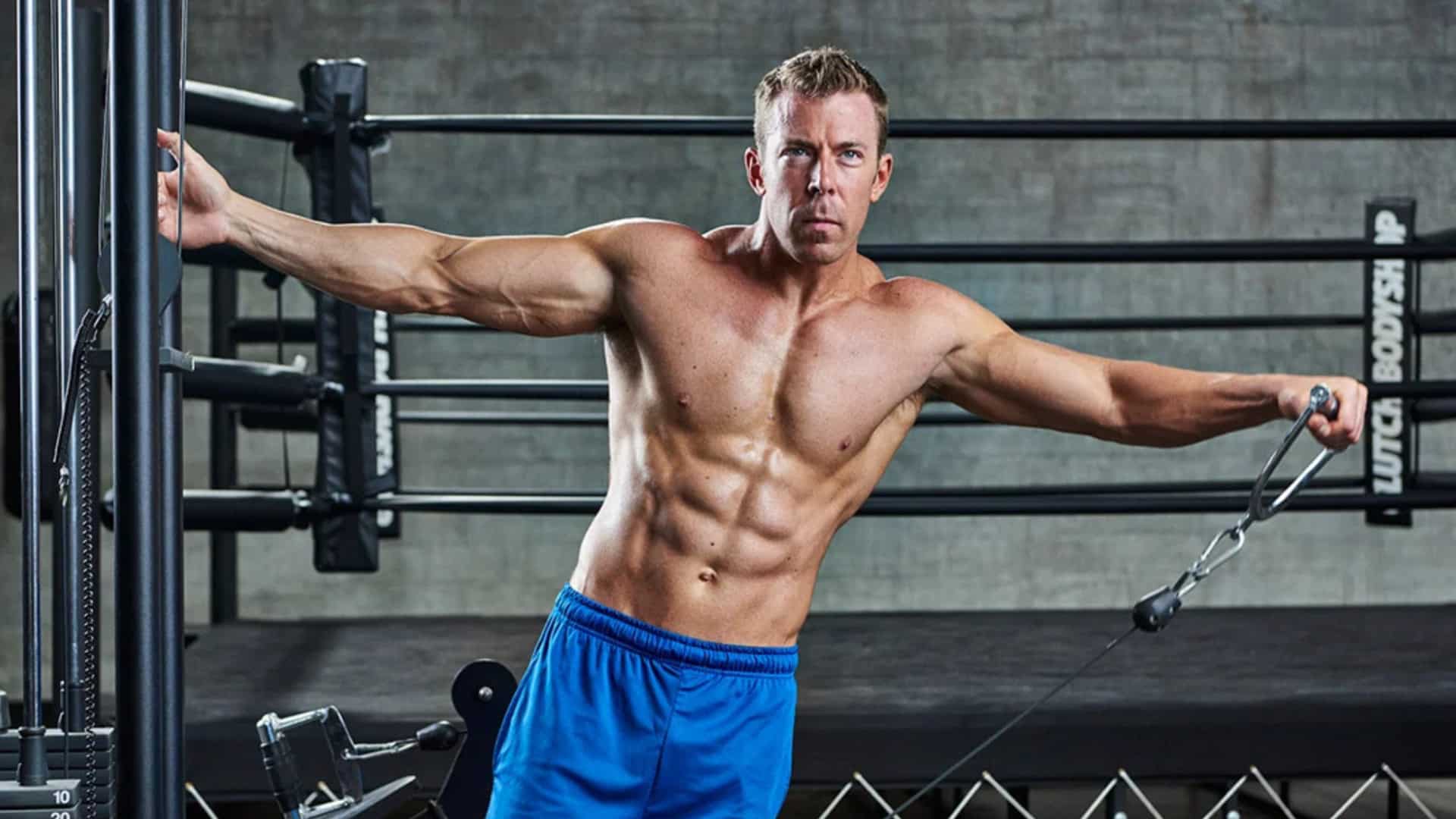
- How to Train the Lateral Deltoid
- 20 Best Lateral Deltoid Exercises
- 1. Dumbbell Lateral Raise
- 2. Upright Row
- 3. Leaning Dumbbell Lateral Raise
- 4. Chest Supported Dumbbell Lateral Raise
- 5. Incline Dumbbell Lateral Raise
- 6. Dumbbell Shoulder Press
- 7. Arnold Shoulder Press
- 8. Dumbbell Monkey Row
- 9. Barbell Overhead Press
- 10. Behind-the-Neck Press
- 11. Barbell Upright Row
- 12. Cable Upright Row
- 13. One Arm Cable Lateral Raise
- 14. Cable Y Raises
- 15. Forearm Side Plank
- 16. Side Plank Lateral Raise
- 17. Pike Push Up
- 18. Handstand Push Up
- 19. Resistance Band Lateral Raise
- 20. Resistance Band Upright Row
- Side Delt Workout Plan
- 1. As a Standalone Exercise
- 2. As Part of a Shoulder Workout
- 3. As Part of a Full-Body Workout
- Conclusion
- References
How to Train the Lateral Deltoid
Understanding deltoid biomechanics, origin, and insertion is essential for effectively training the lateral deltoid (middle deltoid).
In fitness, “shoulder exercises” refer to resistance exercises that target the deltoid muscle.
The deltoid muscle of the shoulder consists of three separate sections or heads.

- Anterior deltoid (In front): It arises from your collarbone and inserts into your humerus (upper arm bone). Its primary function is to move your arm up, forward, and to your center.
- Posterior deltoid (behind): It arises from the spine of your scapula (upper part of your shoulder blade) and inserts into your humerus. Its primary function is to move the arm outward and backwards.
- Lateral deltoid (Side Delt): It originates from the acromion of the scapula and inserts into the deltoid tuberosity of the humerus. Its primary function is shoulder abduction (lifting the arm away from the body)
To train the lateral deltoid effectively, it is necessary to perform exercises that involve abducting the humerus against resistance (lifting your upper arm out to the side, away from your body), primarily in the frontal or scapular plane.
The best examples for this are lateral raises and upright rows.
It’s most active in abduction from approximately 15 degrees (after the supraspinatus initiates the movement) up to around 90-100 degrees (arm parallel to the floor or slightly above).
Beyond this range, other muscles like the trapezius and serratus anterior become increasingly dominant in upwardly rotating the scapula to allow further elevation.
20 Best Lateral Deltoid Exercises
You should incorporate these top 20 lateral deltoid exercises into your regular shoulder workout routine.
The exercises listed below can be performed with body weights, resistance bands, cable machines, dumbbells, and barbells.
1. Dumbbell Lateral Raise
The dumbbell lateral raise is a foundational isolation exercise for developing the deltoid’s lateral (middle) head. It’s giving you those shapely and strong shoulders you’ve always wanted.
Unlike other exercises that work multiple muscle groups, this one goes straight to the side delts.
That means you can really focus on building them up and getting that nice shoulder shape. It’s a must-do exercise for your lateral deltoid workout.
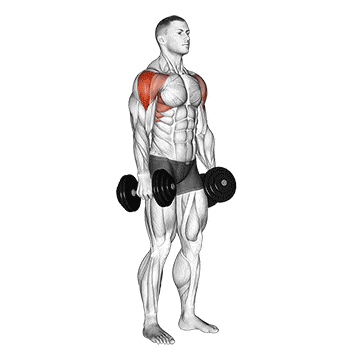
How To Do
- Stand with feet shoulder-width apart, core engaged, and knees slightly bent. A seated variation can offer more stability and reduce cheating.
- Hold dumbbells with a neutral grip (palms facing the body).
- Hang your arms by your sides or slightly in front of your hips (this pre-tensions the lateral delts for some).
- The elbows should have a very slight, consistent bend throughout the movement—do not lock them out, and do not turn it into a rowing/curling motion.
- Raise the dumbbells out to the sides. Focus on leading with the elbows, not the hands. Imagine your hands are just hooks.
- Raise the arms until they are approximately parallel to the floor (around 90 degrees of abduction).
- Going significantly higher often increases traps and reduces lateral deltoid tension, so do not go above 90-100 degrees.
- Lower the dumbbells slowly and under control, resisting gravity. Don’t just let them drop.
- Exhale as you exert force (lifting the dumbbells). Inhale as you lower the dumbbells.
2. Upright Row
The upright row is a compound weightlifting exercise that involves multiple joints and simultaneously engages several muscle groups. It primarily targets the deltoids (lateral Deltoid) and trapezius, while also working the biceps, forearms, and upper back.
One thing I like about the upright row is that it challenges your body’s vertical pulling strength. Research shows that it is one of the best exercises for building shoulder strength and stability.
Most pulling exercises are horizontal (like rows) or overhead (like pull-ups). The upright row fills this middle ground, helping to round out your pulling strength in all directions.
You can do many variations of the upright row with barbells, dumbbells, cables, and other gym equipment. You can also use different grips. I like the cable upright row.
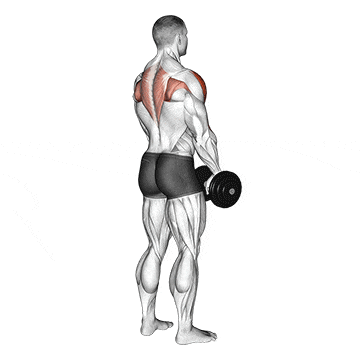
How To Do
- Hold the dumbbells at arm’s length down by your thighs with your palms facing towards you.
- Your grip should be just less than shoulder width.
- Lift the dumbbell and get it as close as possible to chest height using your arms.
- Keep a controlled motion and avoid jerky movements.
- Now, lower the dumbbell under controlled motion until it returns to its starting position.
- Repeat for 8 to 12 reps.
3. Leaning Dumbbell Lateral Raise
The primary benefit of leaning is that it increases the resistance and muscular tension at the beginning of the range of motion (the stretched position), where the standard dumbbell lateral raise offers very little.
Use lighter weights than your standard lateral raise. The increased tension and range make this variation more challenging, and strict form is essential to avoid shoulder strain.
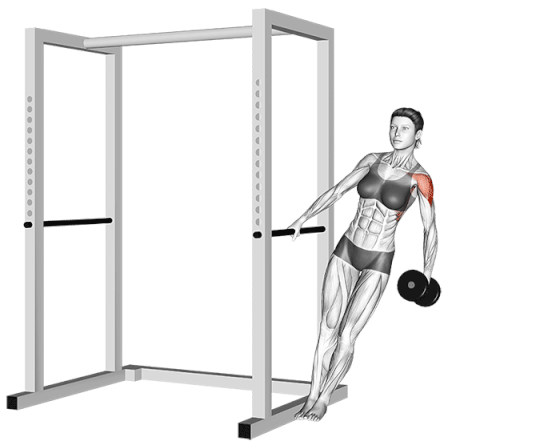
How To Do
- Find a sturdy, immovable object to hold onto (e.g., squat rack post, Smith machine bar, sturdy pole).
- Stand sideways to the support. Hold the dumbbell in the hand furthest from the support.
- Grasp the support with your free hand. Pull your torso away from the support and keep your body straight from your head to your heels.
- The angle at which you lean really impacts how challenging it is. A steeper lean can make things a bit tougher. Find a comfortable angle of about 20–30 degrees from vertical.
- Let the dumbbell hang straight down towards the floor. Ensure a slight, consistent bend in the working elbow.
- Raise the dumbbell out to the side, until your humerus is about 90 degrees abducted relative to your torso. Due to the lean, the dumbbell might not reach the same height relative to the ground as in a standard raise.
- Slowly lower the dumbbell back to the starting position, controlling the descent all the way into the stretch.
4. Chest Supported Dumbbell Lateral Raise
The chest-supported lateral raise is a potent isolation exercise that improves lateral deltoid activation by providing an optimal line of resistance and minimising the ability to use momentum or “cheat” the weight up.
I often program this for clients looking to maximise side delt hypertrophy and minimise upper trap dominance.
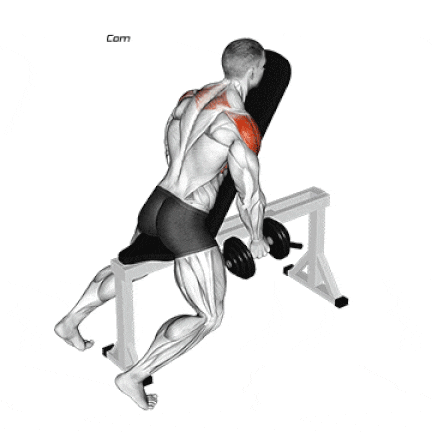
How To Do
- Set an adjustable bench at an incline of approximately 45–60 degrees. Experiment to find what feels best and allows for good deltoid activation.
- Lie on your side on the bench, with your bottom arm either bracing against the seat/frame or tucked under your head for support.
- Hold a dumbbell in your top hand with a neutral grip. Let the arm hang straight down across the front of your body.
- Raise the dumbbell in an arc directly out to your side (abducting the humerus).
- Maintain the slight elbow bend. Ensure your hand does not go higher than your elbow.
- Pause a moment at the top of the motion before slowly lowering the weights to the starting position.
5. Incline Dumbbell Lateral Raise
If you’re looking for a way to get more creative with your lateral delt workout, why not try an incline dumbbell lateral raise?
A biomechanically optimised movement isolates the lateral deltoid more effectively than standard lateral raises.
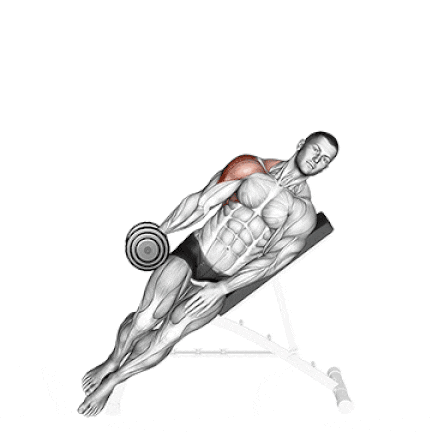
How To Do
- Set an adjustable bench at an incline between 30 and 60 degrees. A 30-45 degree angle is a common starting point.
- Lie on your side on the bench. Hold a dumbbell in your top hand using a neutral grip.
- Abduct the humerus by raising the dumbbell in a smooth arc to your side.
- Lift the dumbbell until your arm is approximately parallel to the floor, or until your humerus is about 90 degrees abducted relative to your torso.
- Pause a moment at the top of the motion before slowly lowering the weights to the starting position.
- Complete all repetitions for one side before carefully switching to the other.
6. Dumbbell Shoulder Press
It is a foundational compound exercise for building deltoid mass, especially the anterior and lateral heads.
It can be performed seated or standing. For hypertrophy, I typically start with seated to isolate the delts more. Standing is better for metabolic conditioning or functional fitness goals.
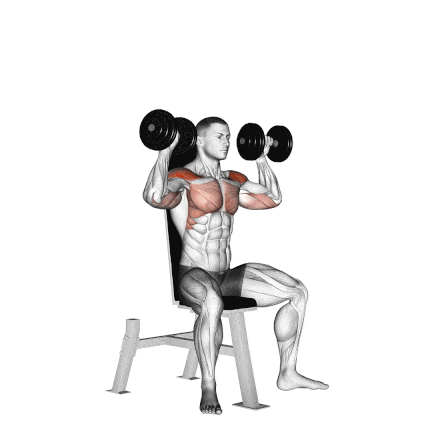
How To Do
- Sit on an upright bench, ideally with back support set at 90 degrees or very slightly reclined (e.g., 80 degrees). Plant your feet firmly on the floor.
- Hold a dumbbell in each hand, resting them on your thighs.
- The palms can face forward (pronated grip—classic) or face each other (neutral grip—often more comfortable for some individuals).
- Safely “kick” the dumbbells up from your knees one at a time to shoulder height, or have a spotter hand them to you.
- Press the dumbbells upward and slightly inward (arcing motion) until your arms are nearly fully extended overhead. Avoid clanking the dumbbells together at the top, as this can momentarily remove tension.
- Briefly pause at the top and then slowly lower the dumbbells back to the starting position.
7. Arnold Shoulder Press
The Arnold dumbbell press is an excellent exercise for strengthening the shoulders. It is a variation on the standard overhead press that adds a rotational element, increasing the range of motion and working more muscles.
The rotational component of theit uniquely activates all three heads of the deltoid.
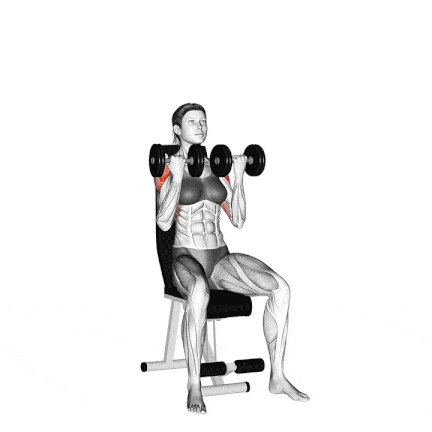
How To Do
- Sit on a bench, preferably with back support, and firmly plant your feet on the floor.
- Hold a dumbbell in each hand.
- Lift the dumbbells to shoulder height, palms facing your body (supinated grip). Your elbows should be bent and slightly in front of your torso.
- As the dumbbells rise, start rotating your wrists so that by the time they reach the peak of the exercise, your palms gradually shift from facing your body to facing forward.
- Continue pressing until your arms are fully extended overhead, but avoid locking out the elbows completely to maintain tension on the deltoids.
- Briefly pause at the top with the dumbbells overhead and palms facing forward.
- Slowly lower the dumbbells back towards your shoulders.
8. Dumbbell Monkey Row
If you’re looking for a way to get more creative with your side delt exercises, why not try this?
Dumbbell Armpit Row, or monkey Row, offers a great alternative to the upright row for trap and side deltoid development.
The primary action in monkey rows involves pulling the dumbbells upward while flaring the elbows to the sides, directly engaging the lateral deltoid through shoulder abduction.
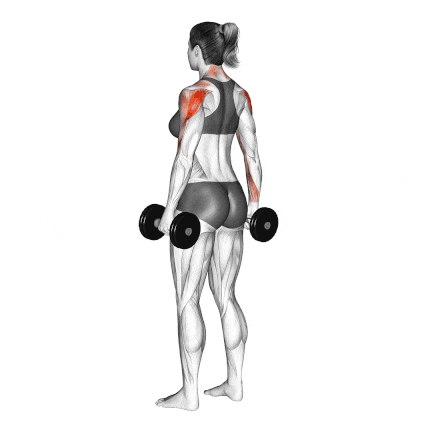
How To Do
- Stand holding a pair of dumbbells by your sides, with your palms facing your thighs.
- Exhale as you pull the dumbbells up the sides of your torso towards your armpits, with your elbows pointing out to the sides.
- Hold for a count of two. Inhale as you lower the dumbbells to the starting position.
- Avoid excessive shrugging, as this can shift the emphasis to the traps instead of the side delts.
9. Barbell Overhead Press
The Overhead press is the best shoulder muscle mass builder exercise. The shoulder Press remains the granddaddy of all shoulder exercises to build big, round shoulder muscles.
The seated shoulder press is the favourite shoulder exercise among bodybuilders because it builds muscle fast and is a power move.
Doing the exercise while sitting up straight is a more challenging option compared to standing. It helps you avoid using your legs for momentum, ensuring that you’re really engaging the targeted muscles.
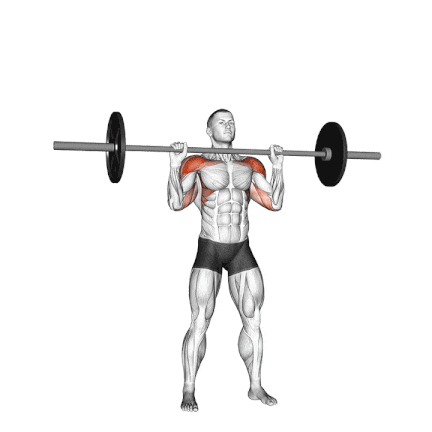
How To Do
- Sit on an exercise bench and grab a bar with an overhand grip.
- Bring the bar over and in front of your head, under your chin, and just above your upper chest.
- Now, press the bar straight up overhead until your arms are fully extended but not locked out.
- Slowly lower the bar back to the starting position.
10. Behind-the-Neck Press
The standard military press and the overhead dumbbell presses hit more of the anterior head of the deltoid, which is often stimulated a lot, even during the bench press.
On the other hand, the behind-the-neck press stimulates all three heads of the shoulder and recruits the triceps, lateral delts, traps, and rhomboids.
This exercise is not recommended if you do not have a fair amount of shoulder mobility.
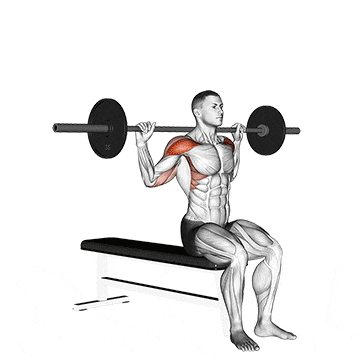
How To Do
- Sit on an exercise bench and place the barbell just below shoulder height.
- Elevate the barbell overhead by fully extending your arms while breathing out.
- Hold the contraction for a second and lower the barbell back to the starting position by inhaling.
- Don’t bounce the bar off your neck. Perform the exercise in a slow and controlled manner.
- Repeat for the desired number of repetitions.
11. Barbell Upright Row
The upright row is one of the excellent side delt exercises to build substantial trapezius muscles and lateral deltoids.
Barbell upright rows can be done with both narrow grips and wider ones.
- The narrow grip focuses on the trapezius,
- And the wider focus on the entire shoulder girdle.
- Moreover, the wider grip allows some cheating movement, allowing you to lift more weight.
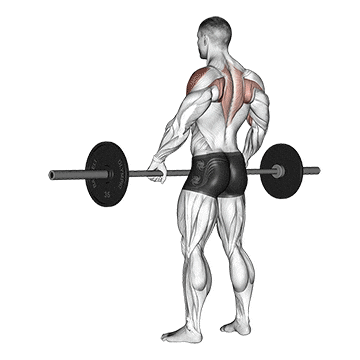
How To Do
- Hold a bar with a narrow overhand grip and let it hang before you.
- Lift the bar as close as possible to the chin, using your arms and elevating your shoulders to squeeze your trapezius muscles.
- Now, lower the bar under controlled motion until it returns to its starting position.
- Keep a controlled motion and avoid jerky movements.
- Repeat for desired reps.
12. Cable Upright Row
Cable upright row is incredibly effective for hitting the upper traps and the side and front deltoids.
The upright row involves shoulder abduction (lifting the arm away from the midline), which trains the side delt, and scapular elevation (a shrugging motion), which trains the upper trap.
However, this is a big issue. From my perspective as a trainer, it’s an exercise that often gets a bad rap—and for good reason. Done incorrectly, it can cause shoulder pain. But with strict form and awareness, it can be a valuable tool.
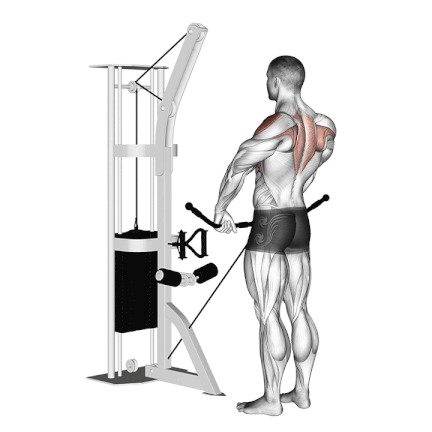
How To Do
- Stand facing a cable machine with a straight bar attachment on the low pulley. For potentially more comfort, you can also use a rope or two D-handles.
- Grab the bar with an overhand grip with a wider grip (hands closer to shoulder-width apart), which reduces some internal rotation, making it safer for some. I often recommend starting with a wider grip.
- Stand tall with your feet shoulder-width apart. Your arms should be extended downwards.
- Begin the movement by pulling the bar straight up towards your chin
- STOP PULLING WHEN YOUR ELBOWS REACH SHOULDER HEIGHT OR JUST BELOW.
- Slowly and with control, lower the weight back down to the starting position.
13. One Arm Cable Lateral Raise
The one-arm cable lateral raise is an isolated shoulder exercise that targets the side deltoids and increases stability in the wrists and core.
You can use both arms while performing the exercise, but it is often recommended to use just one to make the workout more difficult and stimulate more gains.
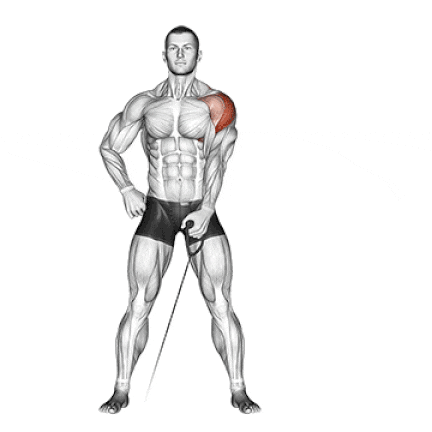
How To Do
- You should stand next to a cable pulley machine with your feet shoulder-width apart and the handle attachment set to the lowest setting.
- Ensure your torso is still, your back is straight, and your elbow is slightly bent.
- Keep your elbow slightly bent and raise your arm to shoulder height.
- Hold for a second, and then slowly lower the weight back to the starting position.
14. Cable Y Raises
The Cable Y Raise is a highly effective isolation exercise for strengthening the rear delts, lower traps, and rotator cuff stabilisers.
Y-raises involve the lower trapezius for scapular upward rotation and depression, aided by the serratus anterior for rotation and protraction. The posterior deltoids and sometimes supraspinatus perform shoulder abduction/flexion. The middle trapezius may assist with retraction, and the rotator cuff stabilizes the joint.
You can do this exercise with one arm at a time, but training both arms equally will help you avoid muscle imbalances and keep everything in harmony.
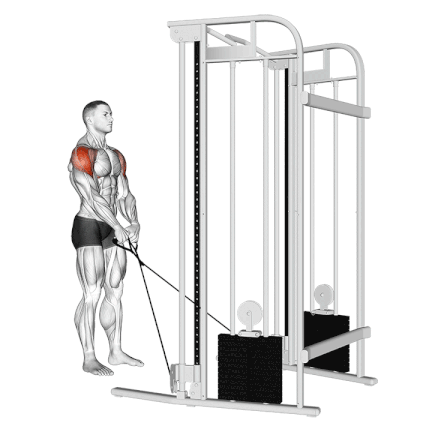
How To Do
- Set up a cable machine with the pulleys set as low as possible. Attach a single D-handle to each cable.
- Grab a D-handle in each hand using an overhand grip (palms facing down).
- Stand facing the cable machine. Take one or two steps back to create tension, ensuring the weight stack is slightly off the pins.
- Your arms should be extended downwards and slightly in front of you. Maintain a slight forward lean from your hips.
- Keep your arms relatively straight (a slight bend in the elbow is fine). Raise both arms simultaneously, making a letter ‘Y’ shape.
- Raise your arms until they are roughly in line with your torso (or slightly above, if comfortable and controlled)
- Avoid shrugging your upper traps excessively towards your ears; the focus is on upward rotation and depression of the scapula’s lower tip.
- Slowly lower your arm back to the starting position. Do 10–12 repetitions for 3 sets.
15. Forearm Side Plank
The forearm side plank is one of the best abs and side delt exercises for strengthening the oblique abdominal muscles and deltoid.
If you’re new to planking, you should master the basic forearm plank before moving on to the side plank variation.
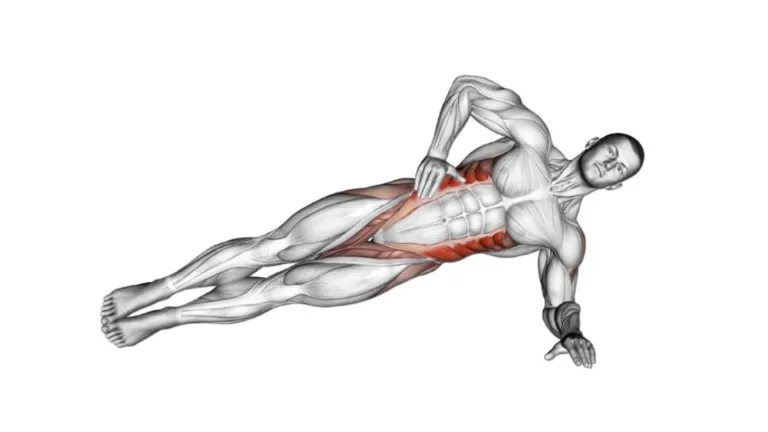
How To Do
- Place your right foot on the floor, with your left foot resting on top of the inner side of your right foot.
- Raise your body by placing your right forearm flat on the floor to be perpendicular to your torso.
- Lift your torso until your right upper arm is straight underneath you, with your elbow bent 90 degrees and your forearm flat on the floor.
- In this position, only your right forearm and the outer side of your right foot contact the floor, and your body forms a diagonal line that is at about a 20-degree angle to the floor.
- Keep your abs pulled in tight and hold this position for as long as you can, and then repeat on the left side.
16. Side Plank Lateral Raise
The side plank lateral raise is an exercise that combines an isometric side plank hold with a dumbbell raise to target both the core and the side of the shoulder.
You probably won’t be able to use much weight without disrupting your balance. Even at lightweight, this move can tackle multiple muscle groups in a quick workout.
How To Do
- You can get into a side plank position by lying on your right side on the floor with your left foot resting on top of your right foot.
- Grasp a dumbbell with your upper hand while keeping your arm positioned at your side.
- Lift the weight gradually, being careful not to reach past your shoulder.
- Slowly lower your arm back down.
- Complete the desired no. of repetitions. Repeat on your right side.
17. Pike Push Up
Pike Push-ups are a variation of the push-up that increases strength and stability in the shoulders and triceps.
The hands are approximately 1-1.5x shoulder width, and the head is in line with a neutral spine.
Pike push up is a fairly advanced movement that requires extra attention to form and quality over quantity.
It is important to have enough general mobility before attempting any exercise, and beginners should start with classic push-ups before transitioning to pike push-ups.
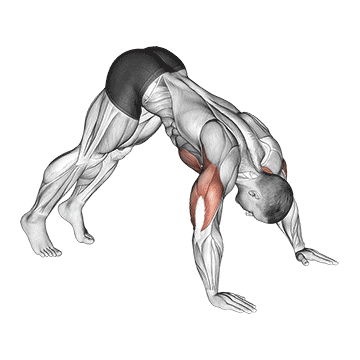
How To Do
- Start in a standard push-up position with your hands slightly wider than shoulder-width apart and elbows completely locked out.
- Lift the hips up and back until your body forms an inverted V shape.
- Keep your arms and legs as straight as you possibly can.
- Slowly lower the top of your head towards the ground.
- Once your head is about to contact the ground, pause for a second.
- Never let your head touch the floor, but try to get as close to it as you can.
- Then slowly push back until your arms are straight, and you’re in the inverted V position.
18. Handstand Push Up
Finally, if you’re looking for a more effective bodyweight lateral delt exercise, try the handstand push-up, also known as a vertical push-up.
The handstand push-up, also known as the vertical push-up, is a type of push-up exercise in which the body is positioned in a handstand.
It is an advanced bodyweight exercise that targets the shoulders, as well as the arms and core.
They require a high degree of upper body strength and skill and should be attempted only after proper training and conditioning.

How To Do
- Place hands about 6–12 inches away from the wall and slightly wider than shoulder-width apart.
- Make sure palms are facing forward or slightly turned out 5–10 degrees.
- Kick up into a handstand with your heels touching the wall.
- Once you have kicked up, establish a strong, rigid midline position.
- While maintaining this position, lower yourself until the top of your head touches the floor.
- Try to keep your elbows at a 45-degree angle as you lower.
- Once your head touches the floor, press up with the same tightness you had, lowering yourself until your elbows reach full extension.
19. Resistance Band Lateral Raise
Resistance bands create variable tension, with light load at the bottom and increasing resistance as you lift.
It is perfect for warm-ups, home workouts, and finisher sets when you can’t get to a gym
It has many Variations that you can try:
- Cross-Band Lateral Raise
- Single-Arm Resistance Band Lateral Raise
- Seated Resistance Band Lateral Raise

How To Do
- Stand on your resistance band with your feet shoulder-width apart and a handle in each hand, or single-handed. Spread your feet wider on the band to increase resistance.
- Tighten your abdominals and avoid arching your back.
- Keep your elbows slightly bent at all times.
- Slowly raise your arms up from the sides of your body
- Once your arms reach parallel with the floor, pause, then slowly lower your arms back down to the starting position.
20. Resistance Band Upright Row
The resistance band upright row targets the upper back and shoulder muscles, including the deltoids, trapezius, rhomboids, and biceps. It is an excellent addition to any full-body workout.
The band keeps tension on the muscles throughout the entire range of motion, ultimately increasing muscle activation and hypertrophy.

How To Do
- Stand with your feet shoulder-width apart. Place the resistance band under your feet. You can adjust the foot width to change the band tension.
- Grab the handles (or the band itself) with an overhand grip (palms facing your body). Your hands should be relatively close together, usually within shoulder-width.
- Start with your arms extended downwards in front of your thighs, maintaining some tension on the band.
- Exhale and pull the band upwards towards your chin. Start by lifting your elbows up and out to the sides.
- Inhale and slowly lower the band with control to the starting position.
Side Delt Workout Plan
The lateral delt exercises can be incorporated into your workout routine in various ways. Here are some options:
- As a standalone exercise: Do on 3–4 sets of 8–12 reps.
- As part of a shoulder workout: Do them along with other shoulder exercises.
- As part of a full-body workout: Do them with other compound exercises like squats, deadlifts, and bench presses.
1. As a Standalone Exercise
Goal: Focus on targeting the rear deltoids.
| Exercise | Sets | Reps | Rest Interval |
|---|---|---|---|
| Lateral Raise | 4 | 8-12 | 60 seconds |
2. As Part of a Shoulder Workout
| Exercise | Sets | Reps | Rest Interval |
|---|---|---|---|
| Shoulder Press | 4 | 6-8 | 90 seconds |
| Dumbbell Lateral Raises | 3 | 10-12 | 60 seconds |
| Rear Delt Flys | 3 | 12-15 | 60 seconds |
| Front Raises | 3 | 10-12 | 60 seconds |
3. As Part of a Full-Body Workout
| Exercise | Sets | Reps | Rest Interval |
|---|---|---|---|
| Deadlifts | 3 | 6-8 | 90 seconds |
| Pull-Ups | 3 | 8-10 | 60 seconds |
| Squats | 4 | 8-10 | 90 seconds |
| Shoulder Press | 3 | 12-15 | 60 seconds |
| Bench Press | 3 | 8-10 | 60 seconds |
Conclusion
These lateral deltoid exercises are highly recommended for anyone interested in building a wider shoulder and gaining strength.
It allows for targeted muscle development and provides an overall 3D look to the shoulder. It is easy to do and requires no more scientific details and fancy equipment.
If you include some of the above-mentioned exercises in your shoulder workout routine, you will see positive results.
The results will speak for themselves when you consistently do these lateral deltoid exercises.
Thanks for reading. Enjoy working on your lateral deltoid exercises.
References
- Sweeney S. ELECTROMYOGRAPHIC ANALYSIS OF THE DELTOID MUSCLE DURING VARIOUS SHOULDER EXERCISES. May 2014.
- Campos YAC, Vianna JM, Guimarães MP, et al. Different Shoulder Exercises Affect the Activation of Deltoid Portions in Resistance-Trained Individuals. J Hum Kinet. 2020;75:5-14. Published 2020 Oct 31. doi:10.2478/hukin-2020-0033
- De Duca CJ, Forrest WJ. Force analysis of individual muscles acting simultaneously on the shoulder joint during isometric abduction. J Biomech. 1973;6:385–393

Manish is a NASM-certified fitness and nutrition coach with over 10 years of experience in weight lifting and fat loss fitness coaching. He specializes in gym-based training and has a lot of knowledge about exercise, lifting technique, biomechanics, and more.
Through “Fit Life Regime,” he generously shares the insights he’s gained over a decade in the field. His goal is to equip others with the knowledge to start their own fitness journey.


